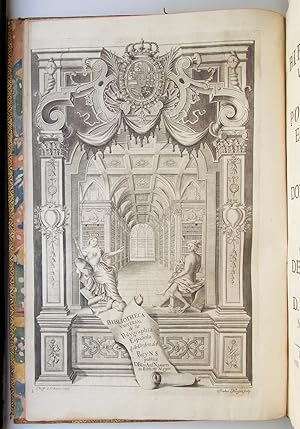Beschreibung
Large folio (41 x 28 cm.), contemporary Spanish mottled calf (spine chipped and joints cracking at head and foot, hinges weak, rubbed), spine richly gilt in seven compartments with red morocco lettering-piece in second compartment from head, gilt border on each cover, marbled endleaves, text-block edges rouged. Lavishly illustrated with engraved plates, vignettes, and initials; woodcut headpieces, illustrations, and initials. Greek type on several pages. Occasional light offsetting from plates and text; 2 folding plates with short tears repaired, without loss; a few small stains and occasional minor soiling. Internally in fine condition; overall very good. Old purple stamp of the Dukes of Palmela (a ducal coronet over the monogram) in blank portion of letterpress title; unidentified armorial label (chipped) at spine foot. Engraved title (numbered 1), (3), xxvii ll., 6 ll. engraved plates (numbered 11, 33-4, 36-8), engraved title (numbered 53, dated 1729), engraved portrait (numbered 54), (36 ll.), 4 engraved calligraphic titles (general title plus section titles introducing plates of fourteenth-, fifteenth- and sixteenth-century scripts) and 123 plates (numbered 55-181; including 3 folding, 1 double-page, and 34 printed on both sides of 17 ll.). Large engraved headpiece, 2 engraved initials, 3 engraved and 35 woodcut illustrations (several full-page) in text. A very good copy in an attractive contemporary binding. *** FIRST EDITION of this fundamental work on Spanish and Portuguese paleography. When Rodriguez began this study in 1708 he thought he would be the first to write about the script of early documents for the general public. While the work was in progress, however, he came across Mabillon's De re diplomatica (1681-1704), which covered only scripts through the tenth century. Rodriguez incorporated about fifteen of Mabillon's plates into this study. Because Rodriguez covers scripts through the sixteenth century, his work is a significant extension of the study of scripts. Bibliotheca universal was the first study of Spanish scripts following Mabillon's.In the prologue (pp. i-xxvii) the editor, D. Blas Antonio Nassarre y Ferriz (the King's chief librarian) explains Rodriguez's theories about script. This section includes thirteen engravings and woodcuts showing more than thirty coins from ancient and medieval times. It also includes engraved and woodcut representations on fifteen leaves of medieval monuments, among them several in Arabic. The prologue is followed by a number of lengthy censuras and aprobaciones that evaluate the usefulness of the work, describe the state of paleographical studies in the early eighteenth century, discuss the various scripts used in Spain and its New World colonies over the centuries, and explain the value of being able to read ancient documents and inscriptions.The main text, which begins with its own engraved title page, has expertly prepared plates, many of which were not only drawn but engraved by Rodriguez himself. The examples are arranged in chronological order with separate section titles for each century, beginning with antiguo (Roman and medieval), then progressing through the fourteenth through sixteenth centuries. There are separate plates for Catalan, Valencian, and Portuguese paleography. Many plates are enhanced by an interlinear transcription in italic script and include an alphabet at the foot of the plate.The plate facing the printed title page shows a library with coffered ceiling whose shelves recede far into the distance. At the left Minerva (crowned and wearing period dress, holding a shield and spear) looks toward the reader and gestures toward the library. On the right Mercury, modestly draped, wears a winged hat and holds a caduceus and also gestures toward the library. The library and its patron deities are set within an elaborate architectural frame. Crowning it are the royal arms of Spain. At the foot, a partially unrolled sheet bears the book's title and the na. Bestandsnummer des Verkäufers 23528
Verkäufer kontaktieren
Diesen Artikel melden
![]()




